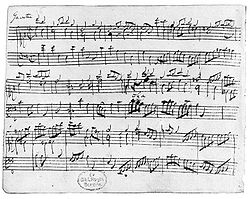Music manuscript
This article needs additional citations for verification. (December 2009) |

Music manuscripts are
Earliest music manuscripts
The earliest written sources of Western European music can be found in medieval manuscripts of the late 9th century that contain liturgical texts.[1] Above these texts small symbols (neumes) indicated the shape of the melodic lines. Only a few manuscripts survive from that time. New systems were devised over the centuries.[2]
Preparation of manuscripts and copying of music
In the past, each composer was required to draw their own staff lines (staves) onto blank paper. Eventually, staff paper was manufactured pre-printed with staves as a labor-saving technique. The composer could then compose music directly onto the lines in pencil or ink.
Until the arrival of more modern methods, music (unless
With the advent of the personal computer in the late 1980s and beyond, music typesetting could now be accomplished by a
See also
References
- ^ Willi Apel, The Notation of Polyphonic Music, 5th ed. (Cambridge, Massachusetts: Medieval Academy of America, 1961).[page needed]
- ^ Geoffrey Chew and Richard Rastall, " Mensural notation from 1500" (Notation, §III, History of Western Notation, 4), New Grove Dictionary of Music and Musicians, rev. ed., 2001.
External links
- Choral Public Domain Library Free downloadable sheet choral music
- Petrucci Music Library Free downloadable sheet music and scans of early editions
- Répertoire International des Sources Musicales, free online database to search for current locations of thousands of music manuscripts from around the world
